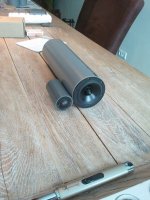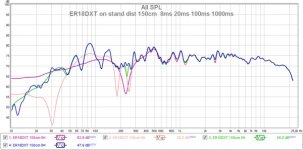Unles really large sphere, standing wave is quite easy to absorb.
Most acoustics phenomena actually scale quite well. Simply proportionally add more damping material to the enclosure and there should be no issue with standing waves.
We can't discuss it all, he said so himself
Actually, there's only one trade secret of importance, which is the way we optimize the acoustic cardioid. Besides that I will not give you an exact how-to if you wish to copy our design. Pretty much all else I'm happy to discuss.
Taking this back to the OP's original question and taking our answer in both the wide and narrow baffle design directions - obviously there is not a "best" approach as 24 pages of discussion has shown - what ARE practical examples of baffle design with at least elements that help with problems with diffraction effects? We did have some already earlier in the thread.
There indeed is not one "best" way to deal with diffraction, there are several methods to deal with it. Some are better than others. Generally though, I think diffraction does not get the attention is deserves. Minimize rapid diffraction and you'll be rewarded with a smoother frequency response, a cleaner impulse and generally a more consistent frequency response within the listening window.
Grimm Audio LS1 has the positioning of the tweeter more central to the relatively wide baffle and beneath the mid so that a curved edge nearest the tweeter is more aesthetically pleasing on the bottom rather if it were on the top.
With a bigger baffle you shift the frequency range where you see diffraction effects downward. In case of the tweeter, you can push the biggest issues down to below its passband. Diffraction issues in the midrange can be pushed to the transition region between the modal range and the range described by ray-acoustics. Those are generally good things.
The Grimm designs sound really superb and I have to admit I've learned a lot from analyzing them. I obviously made a couple of very different design choices, but the LS1 design surely was a big inspiration.
One excellent way to deal with diffraction, I've not seen mentioned here, is to use a minimum amount of baffle. If the membrane is almost as big as the baffle, diffraction is spread out in time and thus its effects are smeared in a very wide frequency range. The result is that there are no clear peaks and dips in the response, and dispersion is smooth. This works really well!
Attachments
As shere has (mainly...) one dimension it will generate a strong internal resonance based on that mode.
French manufaturer Elipson used to fight this using an internal helmotz anti resonator.

French manufaturer Elipson used to fight this using an internal helmotz anti resonator.

Most acoustics phenomena actually scale quite well. Simply proportionally add more damping material to the enclosure and there should be no issue with standing waves.
Good point.
@Gideon - there's more than one way to skin a cat 🙂
The problem with minimal baffle/sphere is that you will loose bafflestep reinforcement, which means more stress for the driver in it's lower band. Could be a problem for a midrange in practise. The effect is not as remarkable as with dipoles and cardioids, but exists and might be a challenge for passive crossover design.
Like many have said, edge interferences can be minimized in many ways, each has it's own caveats. One solution has not been mentioned yet - in-wall mounting! We see that in many recording/mixing studios, AV/movie theatres and at some dedicated listening rooms. But even then tweeters remain critical...
SAM™ Master Studio Monitors | Genelec.com
Like many have said, edge interferences can be minimized in many ways, each has it's own caveats. One solution has not been mentioned yet - in-wall mounting! We see that in many recording/mixing studios, AV/movie theatres and at some dedicated listening rooms. But even then tweeters remain critical...
SAM™ Master Studio Monitors | Genelec.com
Those look nice.I recently finished my speaker set with 10F/8424 in minimum diffraction sphere. 20cm diameter, around 2l sealed filled with wool.
 Ikea bowls? I'd like to see measurements but I'm not sure what to do or look for to find diffraction. Off axis, maybe?
Ikea bowls? I'd like to see measurements but I'm not sure what to do or look for to find diffraction. Off axis, maybe?Member
Joined 2009
Paid Member
I recently finished my speaker set with 10F/8424 in minimum diffraction sphere. 20cm diameter, around 2l sealed filled with wool. My measuring space is limited but I'll try to measure them if anyone is interested. Which measurements would be preferred?
DIY Speaker Set - Album on Imgur
It was your project that triggeredmy comment earlier.
... Seems that it would only require some 'objects' inside the cavity to break up the internal mode without fancy anti-resonators.
Juhazi - in wall is low WAF due to the destruction of the wall, especially in houses with real walls made of brick or stone instead of 'cardboard' like my house. Better to make an on-wall speaker perhaps ? We have the Cornu thread for inspiration.
Last edited:
Better to make an on-wall speaker perhaps ?
Or bookshelf... Imo the main problem with the front wall is that it is never accounted for in loudspeaker design...
Allison did an were actually quite room friendly.
An externally hosted image should be here but it was not working when we last tested it.
An externally hosted image should be here but it was not working when we last tested it.
Btw most active pro monitors come with several preset low end eqs to account for different boundary effects.
But in audiophile integrist litterature they prefer the most radical solution: off the walls!

Last edited:
We are now a bit too far from baffle diffractions, but I agree, typical way of setting hifi speakers at home is far from ideal - more like the worst scenario. Compared to edge diffs, first reflections are way more important, and anyone can do something about them! On-wall, bookshelf, in-wall should not be forgotten!
Speaker Placement 101: How to Fight Boundary Interference
Here are nice simulators, REW has similar tool also hunecke.de | Loudspeakers Calculator
hunecke.de | Room Eigenmodes Calculator
and one for a single reflection Floor/Ceiling Reflection Calculator
Here a floor bounce at various IR gating - from same measurement
Speaker Placement 101: How to Fight Boundary Interference
Here are nice simulators, REW has similar tool also hunecke.de | Loudspeakers Calculator
hunecke.de | Room Eigenmodes Calculator
and one for a single reflection Floor/Ceiling Reflection Calculator
Here a floor bounce at various IR gating - from same measurement
Attachments
Last edited:
The problem with minimal baffle/sphere is that you will loose bafflestep reinforcement, which means more stress for the driver in it's lower band. Could be a problem for a midrange in practise. The effect is not as remarkable as with dipoles and cardioids, but exists and might be a challenge for passive crossover design.
Like many have said, edge interferences can be minimized in many ways, each has it's own caveats. One solution has not been mentioned yet - in-wall mounting! We see that in many recording/mixing studios, AV/movie theatres and at some dedicated listening rooms. But even then tweeters remain critical...
SAM™ Master Studio Monitors | Genelec.com
A link I made earlier in this thread flush mounted in wall studio monitor, any advantages???
Or bookshelf... Imo the main problem with the front wall is that it is never accounted for in loudspeaker design...
Allison did an were actually quite room friendly.
An externally hosted image should be here but it was not working when we last tested it.
Btw most active pro monitors come with several preset low end eqs to account for different boundary effects.
But in audiophile integrist litterature they prefer the most radical solution: off the walls!
Funny you should mention Roy Allison. I owe huge credit to him, because it was reading about the Allison effect that inspired me to incorporate boundary coupled subwoofers in the 8c. It works really well!
A Tribute to Roy F. Allison (1927-2016) | Audioholics
Ok, i think measurements can help assess the technical performance of loudspeakers, which in turn can help assess the subjective performance of sound reproduction.
But i don't believe that stereo can be improved beyond any limit, and reproduction of a real acoustic soundfield is beyond its scope, same as it is for mono, and any multichannel system, even Atmos... Scope have to be humble: try imitate the experience of the real thing in a convincing way with limited means.
for starting,I do not want to put too much meat on fire..
measuring have some limits, the microphone
not work exactly like our brain.
if during reproduction you have lost informations space/time,
the microphone of measure will not know.
We need to reconsider a bit the description how the sound work and especially how our brain perceive and elaborate the sound.
i think that we are bogged down in some old concepts,
in which there is no distinction between the original sound produced by live playing instrument and the same sound when played, again once time the microphone don't know the difference..
Regarding microphones and measurements, i think mikes really allow to make perfect measurements (though maybe not so great recordinds...), the only problem with this being we need to have a clear idea of what measurements do we need and what for.
Member
Joined 2009
Paid Member
If on wall mountng greatly reduces diffraction and also eliminates the baffle step issue for bass dispersion WHY do we have speakers pulled out away from the wall in the first place ????
Because somebody long long time ago had full BSC loudspeakers and it sounded better away from wall. The rest is history.....
WHY do we have speakers pulled out away from the wall in the first place ????
Also, the delayed reflection off a wall 4ft behind gives a nice delayed reflection, adds an illusion of depth. There are other ways to do that, though.
- Home
- Loudspeakers
- Multi-Way
- What are some good example of baffle design to improve diffraction

